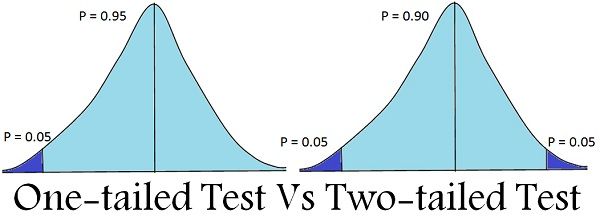

The two ways of carrying out statistical significance test of a characteristic, drawn from the population, with respect to the test statistic, are a one-tailed test and two-tailed test. The one-tailed test refers to a test of null hypothesis, in which the alternative hypothesis is articulated directionally. Here, the critical region lies only on one tail. However, if the alternative hypothesis is not exhibited directionally, then it is known as the two-tailed test of the null hypothesis., wherein the critical region is one both the tails.
To test the hypothesis, test statistics is required, which follows a known distribution. In a test, there are two divisions of probability density curve, i.e. region of acceptance and region of rejection. the region of rejection is called as a critical region.
In the field of research and experiments, it pays to know the difference between one-tailed and two-tailed test, as they are quite commonly used in the process.
| Basis of Comparison | One-tailed Test | Two-tailed Test |
|---|---|---|
| Meaning | A statistical hypothesis test in which alternative hypothesis has only one end, is known as one tailed test. | A significance test in which alternative hypothesis has two ends, is called two-tailed test. |
| Hypothesis | Directional | Non-directional |
| Region of rejection | Either left or right | Both left and right |
| Determines | If there is a relationship between variables in single direction. | If there is a relationship between variables in either direction. |
| Result | Greater or less than certain value. | Greater or less than certain range of values. |
| Sign in alternative hypothesis | > or α , is placed in any one of the two tails. One-tailed test can be: |
The two-tailed test is described as a hypothesis test, in which the region of rejection or say the critical area is on both the ends of the normal distribution. It determines whether the sample tested falls within or outside a certain range of values. Therefore, an alternative hypothesis is accepted in place of the null hypothesis, if the calculated value falls in either of the two tails of the probability distribution.
In this test, α is bifurcated into two equal parts, placing half on each side, i.e. it considers the possibility of both positive and negative effects. It is performed to see, whether the estimated parameter is either above or below the assumed parameter, so the extreme values, work as evidence against the null hypothesis.
The fundamental differences between one-tailed and two-tailed test, is explained below in points:
To sum up, we can say that the basic difference between one-tailed and two-tailed test lies in the direction, i.e. in case the research hypothesis entails the direction of interrelation or difference, then one-tailed test is applied, but if the research hypothesis does not signify the direction of interaction or difference, we use two-tailed test.
Amazing Surbhi. I recently started following this site and I really find it very very useful. The simplicity of language, the key distinctions, range of depth covered in giving the differences. Hats off to you for your effort. Very amazing. I have definitely bookmarked this website as ‘my favorite’ and I shall keep visiting it again and again. Keep it up. Thanks.